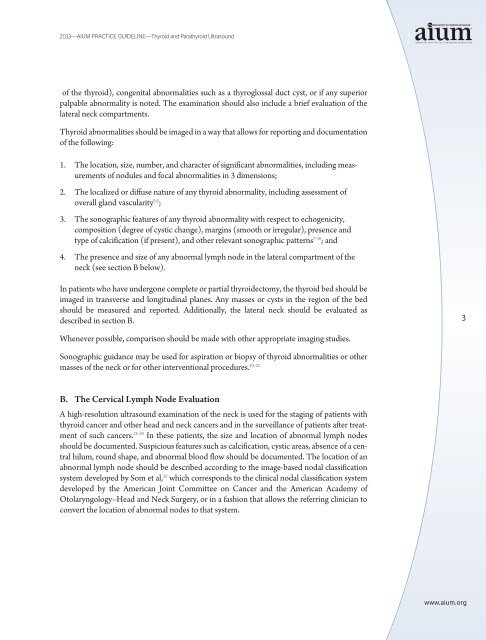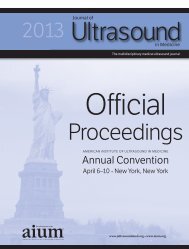Thyroid and Parathyroid Ultrasound Examination - AIUM
Thyroid and Parathyroid Ultrasound Examination - AIUM
Thyroid and Parathyroid Ultrasound Examination - AIUM
Create successful ePaper yourself
Turn your PDF publications into a flip-book with our unique Google optimized e-Paper software.
2013—<strong>AIUM</strong> PRACTICE GUIDELINE—<strong>Thyroid</strong> <strong>and</strong> <strong>Parathyroid</strong> <strong>Ultrasound</strong><br />
of the thyroid), congenital abnormalities such as a thyroglossal duct cyst, or if any superior<br />
palpable abnormality is noted. The examination should also include a brief evaluation of the<br />
lateral neck compartments.<br />
<strong>Thyroid</strong> abnormalities should be imaged in a way that allows for reporting <strong>and</strong> documentation<br />
of the following:<br />
1. The location, size, number, <strong>and</strong> character of significant abnormalities, including measurements<br />
of nodules <strong>and</strong> focal abnormalities in 3 dimensions;<br />
2. The localized or diffuse nature of any thyroid abnormality, including assessment of<br />
overall gl<strong>and</strong> vascularity 5,6 ;<br />
3. The sonographic features of any thyroid abnormality with respect to echogenicity,<br />
composition (degree of cystic change), margins (smooth or irregular), presence <strong>and</strong><br />
type of calcification (if present), <strong>and</strong> other relevant sonographic patterns 7–19 ; <strong>and</strong><br />
4. The presence <strong>and</strong> size of any abnormal lymph node in the lateral compartment of the<br />
neck (see section B below).<br />
In patients who have undergone complete or partial thyroidectomy, the thyroid bed should be<br />
imaged in transverse <strong>and</strong> longitudinal planes. Any masses or cysts in the region of the bed<br />
should be measured <strong>and</strong> reported. Additionally, the lateral neck should be evaluated as<br />
described in section B.<br />
3<br />
Whenever possible, comparison should be made with other appropriate imaging studies.<br />
Sonographic guidance may be used for aspiration or biopsy of thyroid abnormalities or other<br />
masses of the neck or for other interventional procedures. 20–22<br />
B. The Cervical Lymph Node Evaluation<br />
A high-resolution ultrasound examination of the neck is used for the staging of patients with<br />
thyroid cancer <strong>and</strong> other head <strong>and</strong> neck cancers <strong>and</strong> in the surveillance of patients after treatment<br />
of such cancers. 23–29 In these patients, the size <strong>and</strong> location of abnormal lymph nodes<br />
should be documented. Suspicious features such as calcification, cystic areas, absence of a central<br />
hilum, round shape, <strong>and</strong> abnormal blood flow should be documented. The location of an<br />
abnormal lymph node should be described according to the image-based nodal classification<br />
system developed by Som et al, 30 which corresponds to the clinical nodal classification system<br />
developed by the American Joint Committee on Cancer <strong>and</strong> the American Academy of<br />
Otolaryngology–Head <strong>and</strong> Neck Surgery, or in a fashion that allows the referring clinician to<br />
convert the location of abnormal nodes to that system.<br />
www.aium.org
















